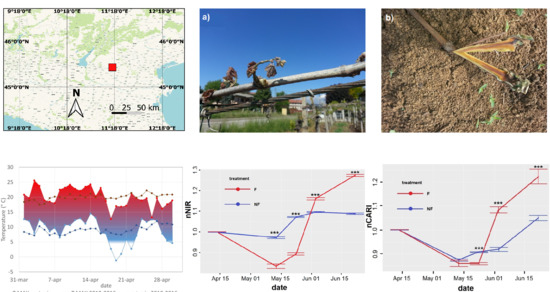Medium-Resolution Multispectral Data from Sentinel-2 to Assess the Damage and the Recovery Time of Late Frost on Vineyards
Abstract
1. Introduction
2. Materials and Methods
2.1. Site Data
2.2. Remote Sensing Data
2.3. Must Quality Data
2.4. Statistical Analyses
3. Results
3.1. Vegetation Indices
3.2. Spectral Bands
3.3. Must Quality Data
4. Discussion
5. Conclusions
Author Contributions
Funding
Acknowledgments
Conflicts of Interest
References
- Meier, M.; Fuhrer, J.; Holzkämper, A. Changing risk of spring frost damage in grapevines due to climate change? A case study in the Swiss Rhone Valley. Int. J. Biometeorol. 2018, 62, 991–1002. [Google Scholar] [CrossRef]
- Lisek, J. Climatic factors affecting development and yielding of grapevine in Central Poland. J. Fruit Ornam. Plant Res. 2008, 16, 285–293. [Google Scholar]
- Leolini, L.; Moriondo, M.; Fila, G.; Costafreda-Aumedes, S.; Ferrise, R.; Bindi, M. Late spring frost impacts on future grapevine distribution in Europe. Field Crop. Res. 2018, 222, 197–208. [Google Scholar] [CrossRef]
- Crimp, S.J.; Zheng, B.; Khimashia, N.; Gobbett, D.L.; Chapman, S.; Howden, M.; Nicholls, N. Recent changes in southern Australian frost occurrence: Implications for wheat production risk. Crop Pasture Sci. 2016, 67, 801–811. [Google Scholar] [CrossRef]
- Molitor, D.; Caffarra, A.; Sinigoj, P.; Pertot, I.; Hoffmann, L.; Junk, J. Late frost damage risk for viticulture under future climate conditions: A case study for the Luxembourgish winegrowing region. Aust. J. Grape Wine Res. 2014, 20, 160–168. [Google Scholar] [CrossRef]
- Sgubin, G.; Swingedouw, D.; Dayon, G.; García de Cortázar-Atauri, I.; Ollat, N.; Pagé, C.; van Leeuwen, C. The risk of tardive frost damage in French vineyards in a changing climate. Agric. For. Meteorol. 2018, 250–251, 226–242. [Google Scholar] [CrossRef]
- Mosedale, J.R.; Wilson, R.J.; Maclean, I.M.D. Climate change and crop exposure to adverse weather: Changes to frost risk and grapevine flowering conditions. PLoS ONE 2015, 10, e0141218. [Google Scholar] [CrossRef] [PubMed]
- Johnson, D.E.; Howell, G.S. Factors Influencing Critical Temperatures for Spring Freeze Damage to Developing Primary Shoots on Concord Grapevines. Am. J. Enol. Vitic. 1981, 32, 144–149. [Google Scholar]
- Trought, M.C.T.; Bennett, J.S.; Boldingh, H.L. Influence of retained cane number and pruning time on grapevine yield components, fruit composition and vine phenology of Sauvignon Blanc vines. Aust. J. Grape Wine Res. 2011, 17, 258–262. [Google Scholar] [CrossRef]
- Fuller, M.P.; Telli, G. An investigation of the frost hardiness of grapevine (Vitis vinifera) during bud break. Ann. Appl. Biol. 1999, 135, 589–595. [Google Scholar] [CrossRef]
- Poling, E.B. Spring cold injury to winegrapes and protection strategies and methods. HortScience 2008, 43, 1652–1662. [Google Scholar] [CrossRef]
- Dami, I. Freezing and Survival Mechanisms of Grapevines. In Proceedings of the Understanding and Preventing Freeze Damage in Vineyards Workshop, Columbia, MO, USA, 5–6 December 2007; pp. 13–20. [Google Scholar]
- Ishikawa, M.; Ide, H.; Yamazaki, H.; Murakawa, H.; Kuchitsu, K.; Price, W.S.; Arata, Y. Freezing behaviours in wintering Cornus florida flower bud tissues revisited using MRI. Plant Cell Environ. 2016, 39, 2663–2675. [Google Scholar] [CrossRef] [PubMed]
- Wisniewski, M.; Gusta, L.; Neuner, G. Adaptive mechanisms of freeze avoidance in plants: A brief update. Environ. Exp. Bot. 2014, 99, 133–140. [Google Scholar] [CrossRef]
- De Leeuw, J.; Vrieling, A.; Shee, A.; Atzberger, C.; Hadgu, K.M.; Biradar, C.M.; Keah, H.; Turvey, C. The potential and uptake of remote sensing in insurance: A review. Remote Sens. 2014, 6, 10888–10912. [Google Scholar] [CrossRef]
- Black, E.; Greatrex, H.; Young, M.; Maidment, R. Incorporating satellite data into weather index insurance. Bull. Am. Meteorol. Soc. 2016, 97, ES203–ES206. [Google Scholar] [CrossRef]
- Bokusheva, R.; Kogan, F.; Vitkovskaya, I.; Conradt, S.; Batyrbayeva, M. Satellite-based vegetation health indices as a criteria for insuring against drought-related yield losses. Agric. For. Meteorol. 2016, 220, 200–206. [Google Scholar] [CrossRef]
- She, B.; Huang, J.F.; Guo, R.F.; Wang, H.B.; Wang, J. Assessing winter oilseed rape freeze injury based on Chinese HJ remote sensing data. J. Zhejiang Univ. Sci. B 2015, 16, 131–144. [Google Scholar] [CrossRef]
- She, B.; Huang, J.F.; Zhang, D.Y.; Huang, L.S. Assessing and characterizing oilseed rape freezing injury based on MODIS and MERIS data. Int. J. Agric. Biol. Eng. 2017, 10, 143–157. [Google Scholar]
- Currit, N.; St Clair, S.B. Assessing the impact of extreme climatic events on aspen defoliation using modis imagery. Geocarto Int. 2010, 25, 133–147. [Google Scholar] [CrossRef]
- LI, Z.-C.; Zhou, Q.-B.; Lu, X.; Lin, H.-R.; Li, S. Hyperspectral Features of Winter Wheat after Frost Stress at Jointing Stage. Acta Agron. Sin. 2008, 34, 831–837. [Google Scholar] [CrossRef]
- Duddu, H.S.N.; Pajic, V.; Noble, S.D.; Tanino, K.K.; Shirtliffe, S.J. Image-Based Rapid Estimation of Frost Damage in Canola (Brassica napus L.). Can. J. Remote Sens. 2018, 44, 169–175. [Google Scholar] [CrossRef]
- Su, B.F.; Xue, J.R.; Xie, C.Y.; Fang, Y.L.; Song, Y.Y.; Fuentes, S. Digital surface model applied to unmanned aerial vehicle based photogrammetry to assess potential biotic or abiotic effects on grapevine canopies. Int. J. Agric. Biol. Eng. 2016, 9, 119–130. [Google Scholar]
- Cogato, A.; Pagay, V.; Marinello, F.; Meggio, F.; Grace, P.; De Antoni Migliorati, M. Assessing the feasibility of using medium-resolution imagery information to quantify the impact of the heatwaves on irrigated vineyards. Remote Sens. 2019, 11, 2869. [Google Scholar] [CrossRef]
- Borgogno-Mondino, E.; Lessio, A.; Tarricone, L.; Novello, V.; de Palma, L. A comparison between multispectral aerial and satellite imagery in precision viticulture. Precis. Agric. 2018, 19, 195–217. [Google Scholar] [CrossRef]
- Sozzi, M.; Kayad, A.; Marinello, F.; Taylor, J.; Tisseyre, B. Comparing vineyard imagery acquired from Sentinel-2 and Unmanned Aerial Vehicle (UAV) platform. OENO One 2020, 54, 189–197. [Google Scholar] [CrossRef]
- Di Gennaro, S.F.; Dainelli, R.; Palliotti, A.; Toscano, P.; Matese, A. Sentinel-2 validation for spatial variability assessment in overhead trellis system viticulture versus UAV and agronomic data. Remote Sens. 2019, 11, 2573. [Google Scholar] [CrossRef]
- Sun, L.; Gao, F.; Anderson, M.C.; Kustas, W.P.; Alsina, M.M.; Sanchez, L.; Sams, B.; McKee, L.; Dulaney, W.; White, W.A.; et al. Daily mapping of 30 m LAI and NDVI for grape yield prediction in California vineyards. Remote Sens. 2017, 9, 317. [Google Scholar] [CrossRef]
- Ciraolo, G.; Capodici, F.; D’Urso, G.; La Loggia, G.; Maltese, A. Mapping evapotranspiration on vineyards: The Sentinel-2 potentiality. In Proceedings of the Sentinel-2 Preparatory Symposium, Frascati, Italy, 23–27 April 2012; p. 707. [Google Scholar]
- Cunha, M.; Marçal, A.R.S.; Silva, L. Very early prediction of wine yield based on satellite data from vegetation. Int. J. Remote Sens. 2010, 31, 3125–3142. [Google Scholar] [CrossRef]
- Hack, H.; Bleiholder, H.; Buhr, L.; Meier, U.; Schnock-Fricke, U.; Weber, E.; Witzenberger, A. Einheitliche Codierung der phänologischen Entwicklungsstadien mono- und dikotyledoner Pflanzen. Erweitere BBCH-Skala, Allgemeine. Nachrichtenbl. Deut. Pflanzenschutzd 1992, 44, 270. [Google Scholar]
- Louis, J.; Debaecker, V.; Pflug, B.; Main-Knorn, M.; Bieniarz, J.; Mueller-Wilm, U.; Cadau, E.; Gascon, F. Sentinel-2 SEN2COR: L2A processor for users. In Proceedings of the ESA Living Planet Symposium 2016, Prague, Czech Republic, 9–13 May 2016; pp. 9–13. [Google Scholar]
- Devaux, N.; Crestey, T.; Leroux, C.; Tisseyre, B. Potential of Sentinel-2 satellite images to monitor vine fields grown at a territorial scale. OENO One 2019, 53, 51–58. [Google Scholar] [CrossRef]
- Kim, M.S.; Daughtry, C.S.T.; Chappelle, E.W.; McMurtrey, J.E. The use of high spectral resolution bands for estimating absorbed photosynthetically active radiation (APAR). In Proceedings of the ISPRS 94, Val d’Isere, France, 17–21 January 1994; pp. 299–306. [Google Scholar]
- Huete, A.; Justice, C.; Van Leeuwen, W. MODIS Vegetation Index (MOD 13); Algorithm Theoretical Basis Document, Version 3; University of Arizona: Tucson, AZ, USA; University of Virginia: Charlotteville, VA, USA, 1999. [Google Scholar]
- Gitelson, A.A.; Merzlyak, M.N. Remote sensing of chlorophyll concentration in higher plant leaves. Adv. Sp. Res. 1998, 22, 689–692. [Google Scholar] [CrossRef]
- Chen, J.M. Evaluation of vegetation indices and a modified simple ratio for boreal applications. Can. J. Remote Sens. 1996, 22, 229–242. [Google Scholar] [CrossRef]
- Haboudane, D.; Miller, J.R.; Pattey, E.; Zarco-Tejada, P.J.; Strachan, I.B. Hyperspectral vegetation indices and novel algorithms for predicting green LAI of crop canopies: Modeling and validation in the context of precision agriculture. Remote Sens. Environ. 2004, 90, 337–352. [Google Scholar] [CrossRef]
- Rouse, J.; Haas, R.; Schell, J.; Deering, D.; Harlan, J. Monitoring the Vernal Advancement and Retrogradation (Greenwave Effect) of Natural Vegetation; NASA: Washington, DC, USA, 1974.
- Baret, F.; Guyot, G. Potentials and limits of vegetation indices for LAI and APAR assessment. Remote Sens. Environ. 1991, 35, 161–173. [Google Scholar] [CrossRef]
- Schmidt, T.; Förster, M.; Kleinschmit, B. Evaluation of estimated satellite images for filling data gaps in an intra-annual high spatial resolution time-series. In Accuracy 2014, Proceedings of the 11th International Symposium on Spatial Accuracy Assessment in Natural Resources and Environmental Sciences, East Lansing, MI, USA, 8–11 July 2014; ISARA: Catania, Italy, 2014; pp. 2–7. [Google Scholar]
- VandeKamp, K.; Rigge, M.; Troelstrup, N.H.; Smart, A.J.; Wylie, B. Detecting channel riparian vegetation response to best-management-practices implementation in ephemeral streams with the use of spot high-resolution visible imagery. Rangel. Ecol. Manag. 2013, 66, 63–70. [Google Scholar] [CrossRef]
- Kogan, F.N. Remote sensing of weather impacts on vegetation in non-homogeneous areas. Int. J. Remote Sens. 1990, 11, 1405–1419. [Google Scholar] [CrossRef]
- Liang, L.; Sun, Q.; Luo, X.; Wang, J.; Zhang, L.; Deng, M.; Di, L.; Liu, Z. Long-term spatial and temporal variations of vegetative drought based on vegetation condition index in China. Ecosphere 2017, 8, e01919. [Google Scholar] [CrossRef]
- Choler, P.; Sea, W.; Leuning, R. A Benchmark Test for Ecohydrological Models of Interannual Variability of NDVI in Semi-arid Tropical Grasslands. Ecosystems 2011, 14, 183–197. [Google Scholar] [CrossRef]
- Potdar, M.B.; Manjunath, K.R.; Purohit, N.L. Multi-season atmospheric normalization of NOAA AVHRR derived NDVI for crop yield modeling. Geocarto Int. 1999, 14, 52–57. [Google Scholar] [CrossRef]
- Zarco-Tejada, P.J.; Ustin, S.L.; Whiting, M.L. Temporal and spatial relationships between within-field yield variability in cotton and high-spatial hyperspectral remote sensing imagery. Agron. J. 2005, 97, 641–653. [Google Scholar] [CrossRef]
- Gao, X.; Huete, A.R.; Ni, W.; Miura, T. Optical-biophysical relationships of vegetation spectra without background contamination. Remote Sens. Environ. 2000, 74, 609–620. [Google Scholar] [CrossRef]
- Bascietto, M.; Bajocco, S.; Ferrara, C.; Alivernini, A.; Santangelo, E. Estimating late spring frost-induced growth anomalies in European beech forests in Italy. Int. J. Biometeorol. 2019, 63, 1039–1049. [Google Scholar] [CrossRef] [PubMed]
- Fraga, H.; Amraoui, M.; Malheiro, A.C.; Moutinho-Pereira, J.; Eiras-Dias, J.; Silvestre, J.; Santos, J.A. Examining the relationship between the Enhanced Vegetation Index and grapevine phenology. Eur. J. Remote Sens. 2014, 47, 753–771. [Google Scholar] [CrossRef]
- Marciniak, M. Use of remote sensing to understand the terroir of the Niagara Peninsula. Applications in a Riesling vineyard. J. Int. Sci. Vigne Vin 2015, 49, 1–26. [Google Scholar] [CrossRef]
- Khaliq, A.; Comba, L.; Biglia, A.; Aimonino, D.R.; Chiaberge, M.; Gay, P. Comparison of satellite and UAV-based multispectral imagery for vineyard variability assessment. Remote Sens. 2019, 11, 436. [Google Scholar] [CrossRef]
- Kazmierski, M.; Glemas, P.; Rousseau, J.; Tisseyre, B. Temporal stability of within-field patterns of ndvi in non irrigated mediterranean vineyards. J. Int. Sci. Vigne Vin 2011, 45, 61–73. [Google Scholar] [CrossRef]
- Ortuani, B.; Facchi, A.; Mayer, A.; Bianchi, D.; Bianchi, A.; Brancadoro, L. Assessing the effectiveness of variable-rate drip irrigation on water use efficiency in a Vineyard in Northern Italy. Water 2019, 11, 1964. [Google Scholar] [CrossRef]
- Feng, M.; Yang, W.; Cao, L.; Ding, G. Monitoring Winter Wheat Freeze Injury Using Multi-Temporal MODIS Data. Agric. Sci. China 2009, 8, 1053–1062. [Google Scholar] [CrossRef]
- Wang, H.; Huo, Z.G.; Zhou, G.; Wu, L.; Feng, H. Monitoring and forecasting winter wheat freeze injury and yield from multi-temporal remotely sensed data. Intell. Autom. Soft Comput. 2016, 22, 255–260. [Google Scholar] [CrossRef]
- Gitelson, A.A.; Viña, A.; Ciganda, V.; Rundquist, D.C.; Arkebauer, T.J. Remote estimation of canopy chlorophyll content in crops. Geophys. Res. Lett. 2005, 32, 1–4. [Google Scholar] [CrossRef]
- Gu, Y.; Brown, J.F.; Verdin, J.P.; Wardlow, B. A five-year analysis of MODIS NDVI and NDWI for grassland drought assessment over the central Great Plains of the United States. Geophys. Res. Lett. 2007, 34, 1–6. [Google Scholar] [CrossRef]
- Heber, U. Conformational changes of chloroplasts induced by illumination of leaves in vivo. Biochim. Biophys. Acta Bioenerg. 1969, 180, 302–319. [Google Scholar] [CrossRef][Green Version]
- Ma, S.; Zhou, Y.; Gowda, P.H.; Dong, J.; Zhang, G.; Kakani, V.G.; Wagle, P.; Chen, L.; Flynn, K.C.; Jiang, W. Application of the water-related spectral reflectance indices: A review. Ecol. Indic. 2019, 98, 68–79. [Google Scholar] [CrossRef]
- Wei, C.; Huang, J.; Wang, X.; Blackburn, G.A.; Zhang, Y.; Wang, S.; Mansaray, L.R. Hyperspectral characterization of freezing injury and its biochemical impacts in oilseed rape leaves. Remote Sens. Environ. 2017, 195, 56–66. [Google Scholar] [CrossRef]
- Li, F.; Miao, Y.; Feng, G.; Yuan, F.; Yue, S.; Gao, X.; Liu, Y.; Liu, B.; Ustin, S.L.; Chen, X. Improving estimation of summer maize nitrogen status with red edge-based spectral vegetation indices. Field Crop. Res. 2014, 157, 111–123. [Google Scholar] [CrossRef]
- Kasimatis, A.N.; Kissler, J.J. Responses of grapevines to shoot break-out following injury by spring frost. Am. J. Enol. Vitic. 1974, 25, 17–20. [Google Scholar]
- Marcon Filho, J.L.; Allebrandt, R.; De Bem, B.; Mudrei, P.I.; Macedo, T.A.; Schlemper, C.; Lerin, S.; Outemane, M.; Kretzschmar, A.A.; Rufato, L. Damage to “Cabernet Sauvignon” after late frost in the Southern Brazilian highlands. Acta Hortic. 2016, 1115, 211–216. [Google Scholar] [CrossRef]
- Bergqvist, J.; Dokoozlian, N.; Ebisuda, N. Sunlight exposure and temperature effects on berry growth and composition of Cabernet Sauvignon and Grenache in the central San Joaquin Valley of California. Am. J. Enol. Vitic. 2001, 52, 1–7. [Google Scholar]
- Sadras, V.O.; Petrie, P.R.; Moran, M.A. Effects of elevated temperature in grapevine. II juice pH, titratable acidity and wine sensory attributes. Aust. J. Grape Wine Res. 2013, 19, 107–115. [Google Scholar] [CrossRef]
- Jones, G.V.; Davis, R.E. Climate influences on grapevine phenology, grape composition, and wine production and quality for Bordeaux, France. Am. J. Enol. Vitic. 2000, 51, 249–261. [Google Scholar]

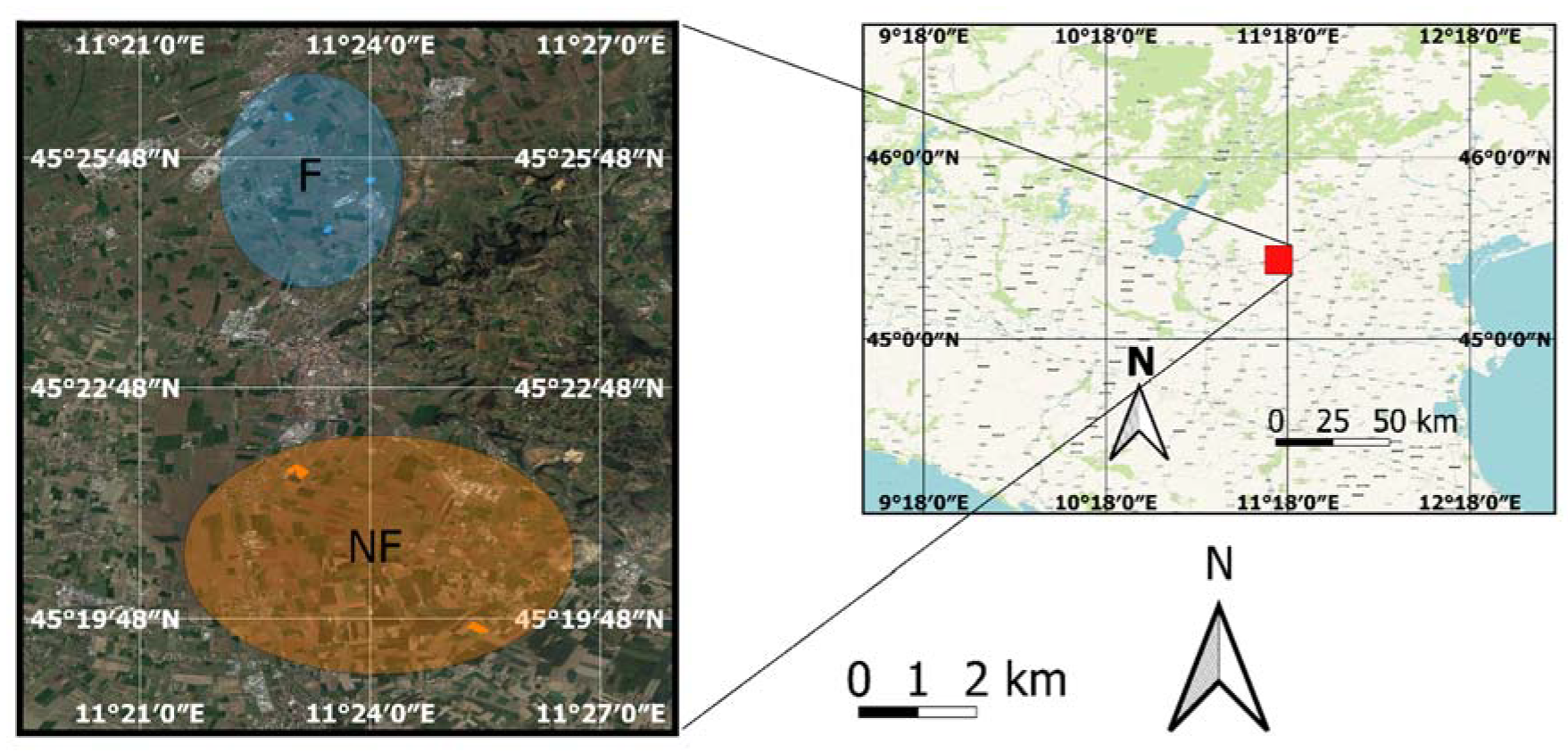
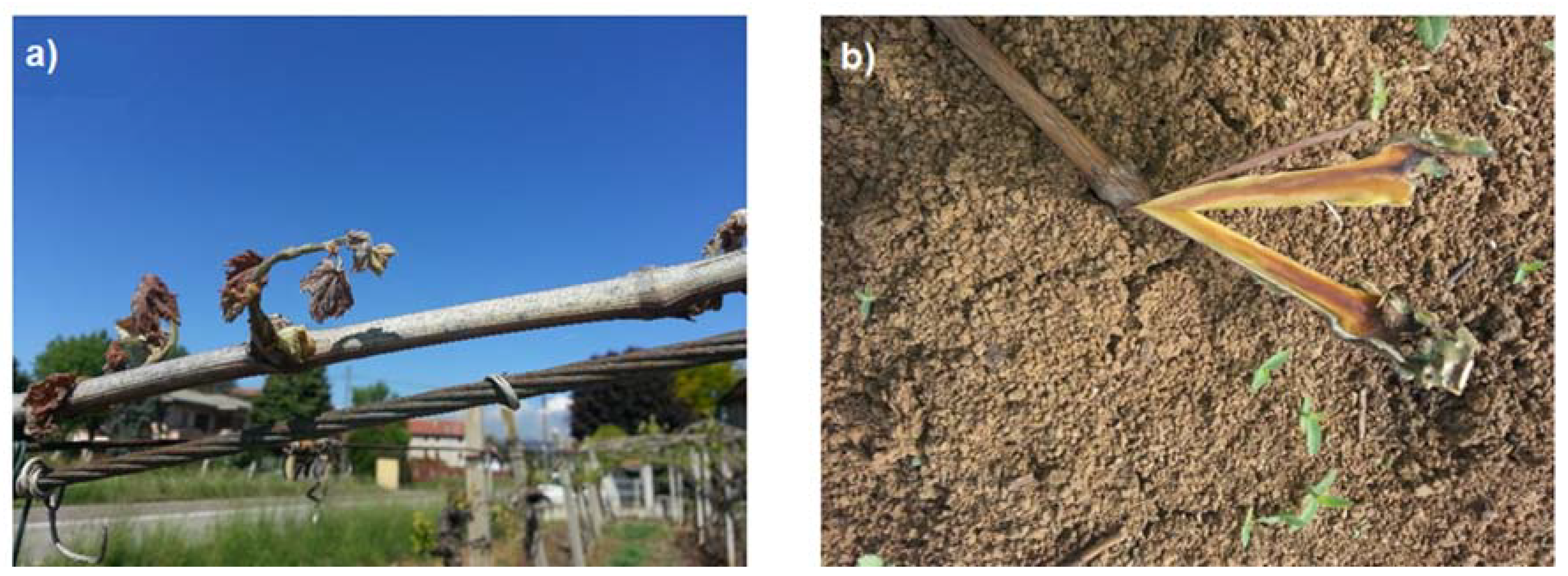
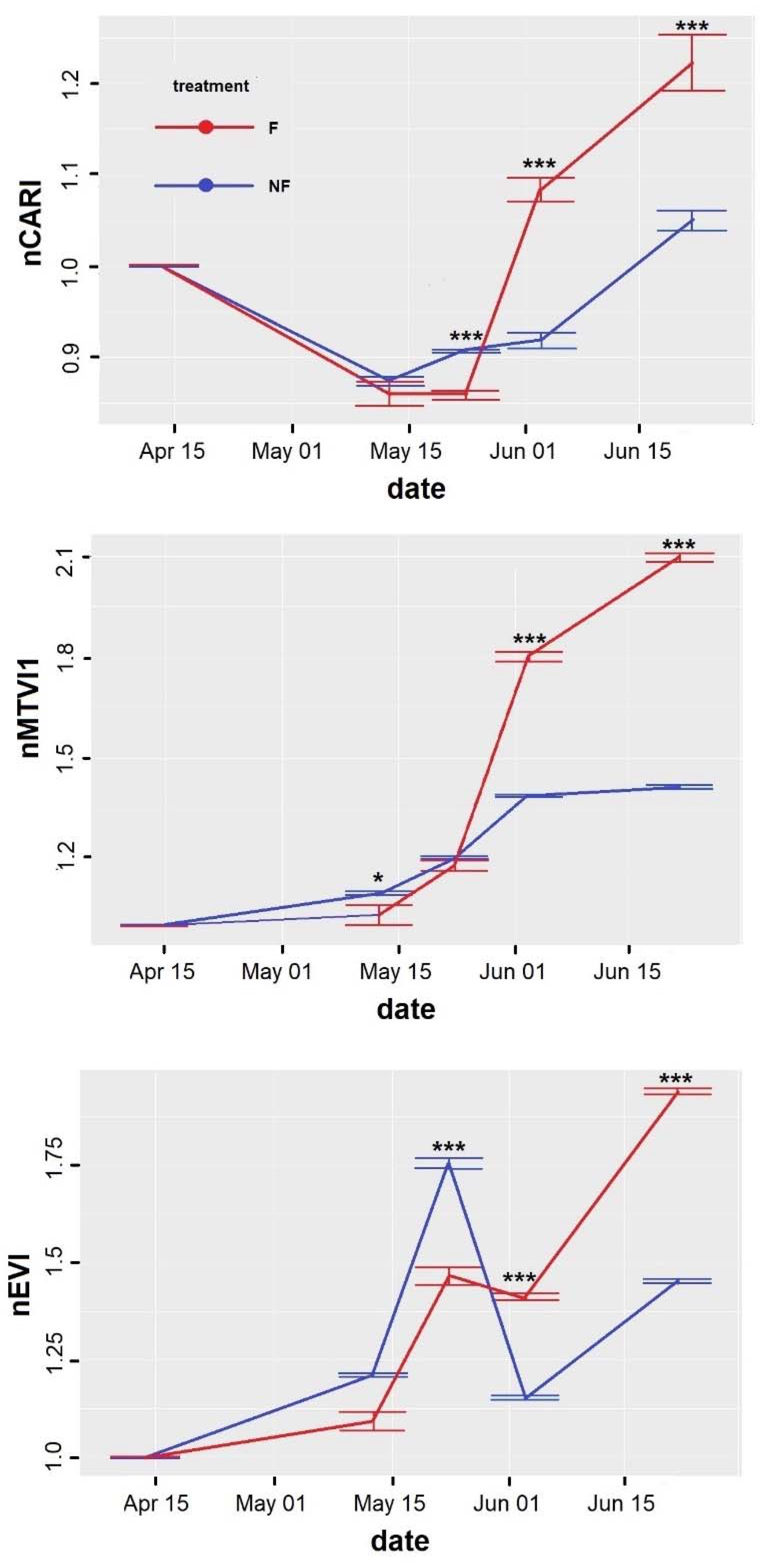
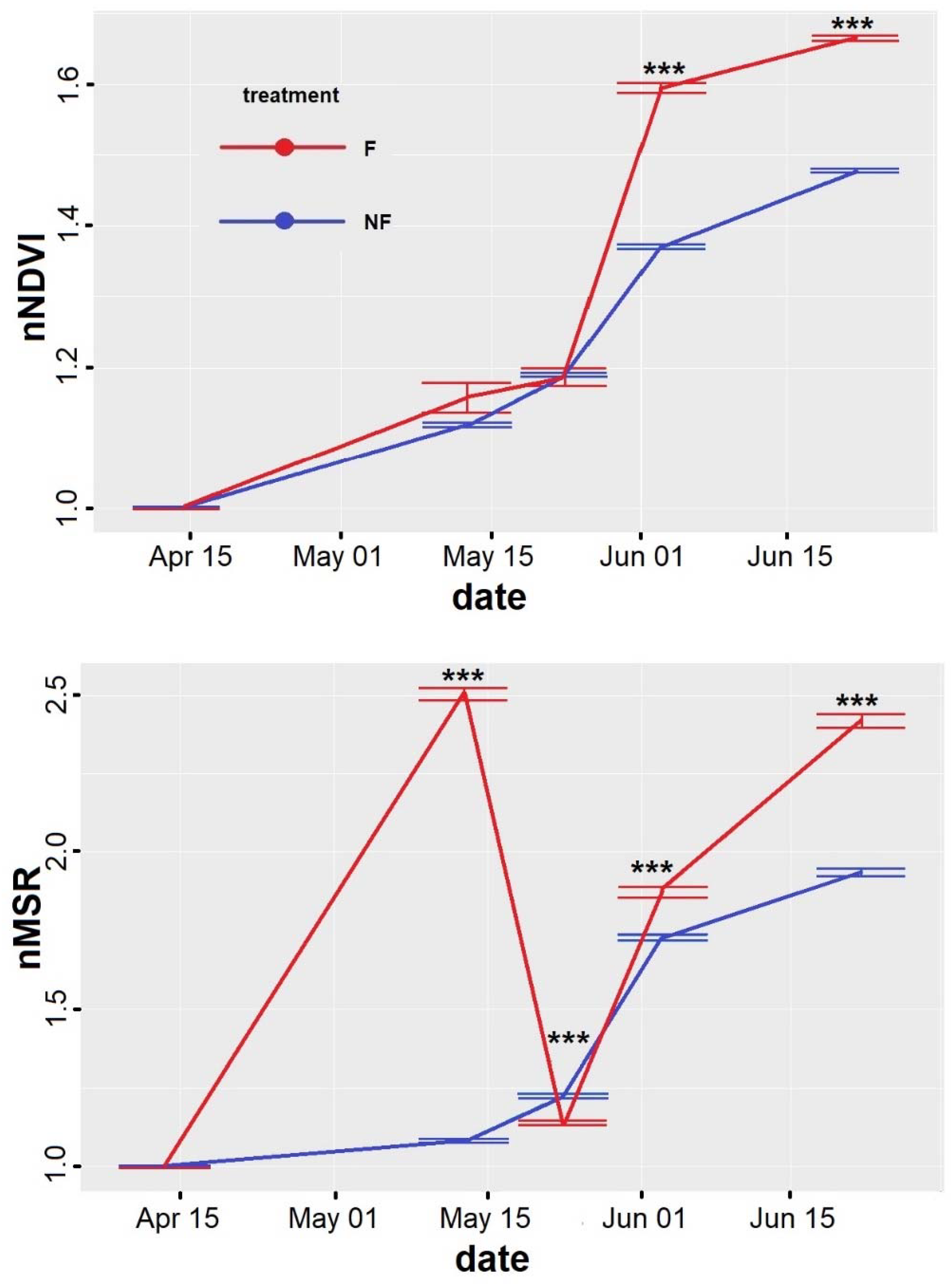
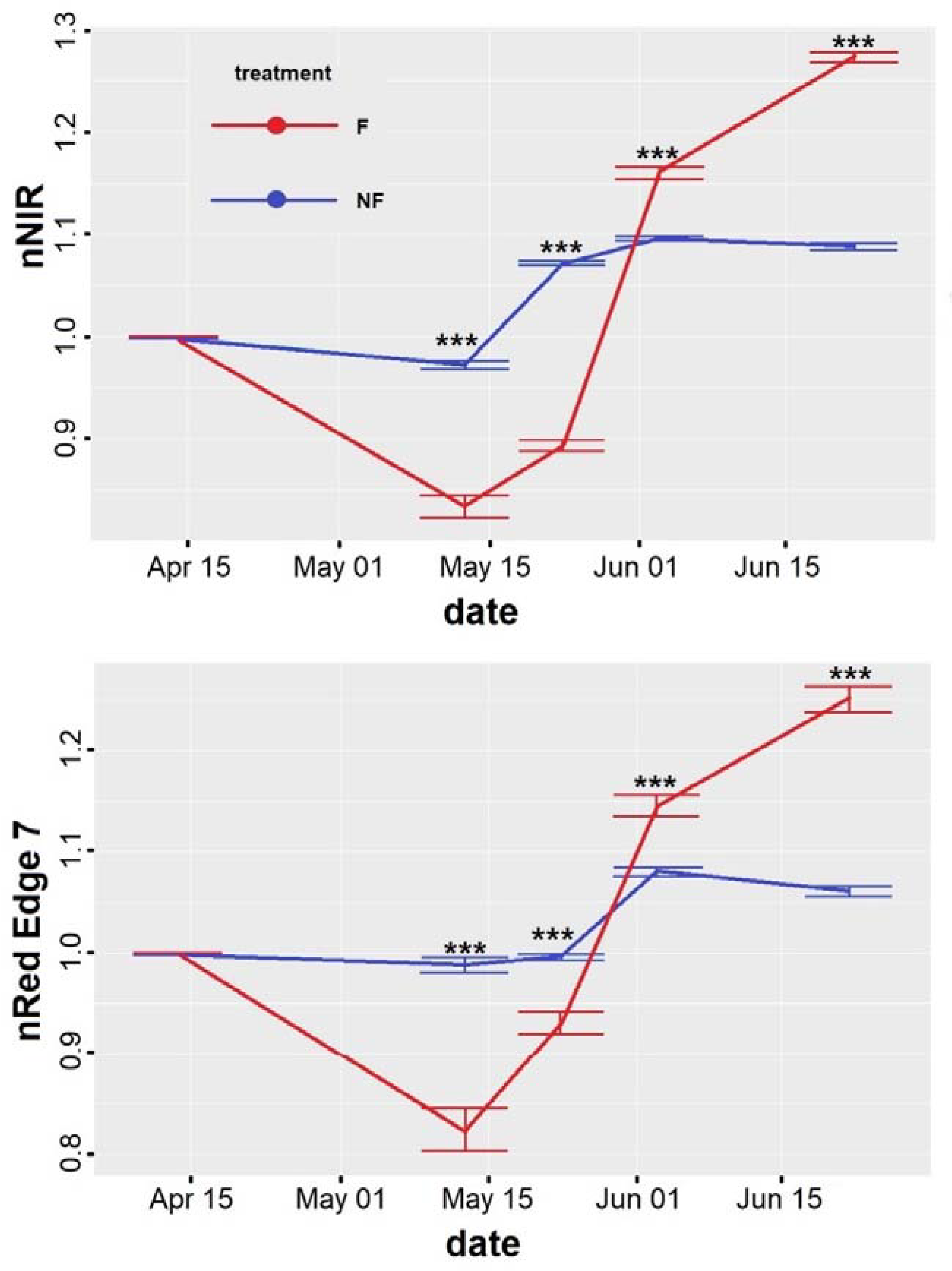

| Plot ID | Area (ha) | Row Spacing | Interrow Management |
|---|---|---|---|
| F1 | 1.78 | 5.0 | Cover crop |
| F2 | 1.66 | 4.2 | Bare soil |
| F3 | 1.52 | 4.5 | Cover crop |
| NF1 | 2.78 | 4.5 | Cover crop |
| NF2 | 3.72 | 4.5 | Cover crop |
| NF3 | 4.93 | 5.0 | Cover crop |
| Image ID. | S1 | S2 | S3 | S4 | S5 |
|---|---|---|---|---|---|
| 14/04/2017 | 14/05/2017 | 24/05/2017 | 03/06/2017 | 23/06/2017 | |
| 14/04/2018 | 19/05/2018 | NA | 03/06/2018 | 18/06/2018 | |
| 19/04/2019 | 14/05/2019 | NA | 03/06/2019 | 23/06/2019 |
| Sentinel-2 Band | Central Wavelength (nm) | Bandwidth (nm) | Spatial Resolution (m) |
|---|---|---|---|
| Band 2—Blue | 490 | 66 | 10–20 |
| Band 3—Green | 560 | 36 | 10–20 |
| Band 4—Red | 665 | 31 | 10–20 |
| Band 5—Vegetation Red Edge | 705 | 15 | 20 |
| Band 6—Vegetation Red Edge | 740 | 15 | 20 |
| Band 7—Vegetation Red Edge | 783 | 20 | 20 |
| Band 8—Near Infrared (NIR) | 842 | 115 | 10 |
| Band 11—Short Wave Infrared (SWIR) | 1610 | 90 | 20 |
| Index | Acronym | Equation | Spatial Resolution (m) | Reference |
|---|---|---|---|---|
| Chlorophyll Absorption Ratio Index | CARI | α = (RED EDGE 5 GREEN)/150 b = (GREEN ((RED EDGE 5 GREEN)/150, 550)) | 20 | [34] |
| Enhanced Vegetation Index | EVI | 10 | [35] | |
| Green Normalized Difference Vegetation Index | GNDVI | 10 | [36] | |
| Modified Simple Ratio | MSR | 10 | [37] | |
| Modified Triangular Vegetation Index 1 | MTVI1 | 10 | [38] | |
| Normalized Difference Vegetation Index | NDVI | 10 | [39] | |
| Soil Adjusted Vegetation Index | SAVI | 10 | [40] |
| VI | Difference (%) | |||
|---|---|---|---|---|
| 14/05/2017 | 24/05/2017 | 03/06/2017 | 23/06/2017 | |
| nCARI | −1.74 (ns) | −5.26 (***) | +17.70 (***) | +16.41 (***) |
| nEVI | −9.77 (ns) | −16.29 (***) | +22.42 (***) | +33.43 (***) |
| nMSR | +130.73 (***) | −7.36 (***) | +8.73 (***) | +24.80 (***) |
| nMTVI1 | −5.77 (*) | −1.91 (ns) | +29.67 (***) | +48.03 (***) |
| nNDVI | +3.49 (ns) | −0.33 (ns) | +16.48 (***) | +12.72 (***) |
| Spectral Band | Difference (%) | |||
|---|---|---|---|---|
| 14/05/2015 | 24/05/2017 | 03/06/2017 | 23/06/2017 | |
| nNIR | −14.33 (***) | −16.65 (***) | +5.89 (***) | +17.04 (***) |
| nRed Edge 7 | −16.67 (ns) | −6.53 (***) | +5.91 (***) | +17.90 (***) |
© 2020 by the authors. Licensee MDPI, Basel, Switzerland. This article is an open access article distributed under the terms and conditions of the Creative Commons Attribution (CC BY) license (http://creativecommons.org/licenses/by/4.0/).
Share and Cite
Cogato, A.; Meggio, F.; Collins, C.; Marinello, F. Medium-Resolution Multispectral Data from Sentinel-2 to Assess the Damage and the Recovery Time of Late Frost on Vineyards. Remote Sens. 2020, 12, 1896. https://doi.org/10.3390/rs12111896
Cogato A, Meggio F, Collins C, Marinello F. Medium-Resolution Multispectral Data from Sentinel-2 to Assess the Damage and the Recovery Time of Late Frost on Vineyards. Remote Sensing. 2020; 12(11):1896. https://doi.org/10.3390/rs12111896
Chicago/Turabian StyleCogato, Alessia, Franco Meggio, Cassandra Collins, and Francesco Marinello. 2020. "Medium-Resolution Multispectral Data from Sentinel-2 to Assess the Damage and the Recovery Time of Late Frost on Vineyards" Remote Sensing 12, no. 11: 1896. https://doi.org/10.3390/rs12111896
APA StyleCogato, A., Meggio, F., Collins, C., & Marinello, F. (2020). Medium-Resolution Multispectral Data from Sentinel-2 to Assess the Damage and the Recovery Time of Late Frost on Vineyards. Remote Sensing, 12(11), 1896. https://doi.org/10.3390/rs12111896







